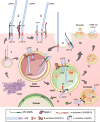Metalloproteinases and their tissue inhibitors in Alzheimer's disease and other neurodegenerative disorders
- PMID: 31197405
- PMCID: PMC11105182
- DOI: 10.1007/s00018-019-03178-2
Metalloproteinases and their tissue inhibitors in Alzheimer's disease and other neurodegenerative disorders
Abstract
As life expectancy increases worldwide, age-related neurodegenerative diseases will increase in parallel. The lack of effective treatment strategies may soon lead to an unprecedented health, social and economic crisis. Any attempt to halt the progression of these diseases requires a thorough knowledge of the pathophysiological mechanisms involved to facilitate the identification of new targets and the application of innovative therapeutic strategies. The metzincin superfamily of metalloproteinases includes matrix metalloproteinases (MMP), a disintegrin and metalloproteinase (ADAM) and ADAM with thrombospondin motifs (ADAMTS). These multigenic and multifunctional proteinase families regulate the functions of an increasing number of signalling and scaffolding molecules involved in neuroinflammation, blood-brain barrier disruption, protein misfolding, synaptic dysfunction or neuronal death. Metalloproteinases and their physiological inhibitors, the tissue inhibitors of metalloproteinases (TIMPs), are therefore, at the crossroads of molecular and cellular mechanisms that support neurodegenerative processes, and emerge as potential new therapeutic targets. We provide an overview of current knowledge on the role and regulation of metalloproteinases and TIMPs in four major neurodegenerative diseases: Alzheimer's disease, Parkinson's disease, amyotrophic lateral sclerosis and Huntington's disease.
Keywords: ADAM; Amyotrophic lateral sclerosis; Huntington’s disease; Neurodegenerative brain disease; Parkinson’s disease; TIMP.
Figures

References
-
- Okada Y (2017) Proteinases and matrix degradation. In: Firestein GS, Budd RC, Gabriel SE, McInnes IB, O’Dell JR (eds) Kelley and Firestein’s textbook of rheumatology, vol 1, 10th edn. Elsevier, Philadelphia, pp 106–125. 10.1016/B978-0-323-31696-5.00008-5
-
- Overall CM, Tam EM, Kappelhoff R, Connor A, Ewart T, Morrison CJ, Puente X, Lopez-Otin C, Seth A. Protease degradomics: mass spectrometry discovery of protease substrates and the CLIP-CHIP, a dedicated DNA microarray of all human proteases and inhibitors. Biol Chem. 2004;385(6):493–504. doi: 10.1515/BC.2004.058. - DOI - PubMed
Publication types
MeSH terms
Substances
LinkOut - more resources
Full Text Sources
Medical
Research Materials
Miscellaneous

